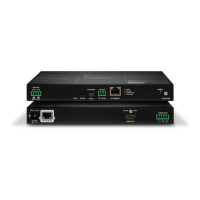10. Technologies HDMI-TPS-RX110AY – User's Manual 74
HDCP Management
The receiver allows transmitting HDCP encrypted and unencrypted signals. The devices will be still HDCP
compliant as they will never output an encrypted signal to a non-HDCP compliant display device. If an
encrypted signal is switched to a non-compliant output, a red screen alert or muted screen will appear.
Protected and Unprotected Content
Many video sources send HDCP protected signal if they detect that the sink is HDCP capable – even if
the content is not copyrighted. This can cause trouble if an HDCP capable device is connected between
the source and the display. In this case, the content cannot be viewed on non-HDCP capable displays and
interfaces like event controllers. Rental and staging technicians often complain about certain laptops, which
are always sending HDCP encrypted signals if the receiver device (display, matrix router, etc.) reports HDCP
compliancy. However, HDCP encryption is not required all the time e.g. computer desktop image, certain
laptops still do that.
detect that the sink is not HDCP capable, and turn off authentication.
Disable Unnecessary Encryption
HDCP Compliant Sink
Protected
content
HDCP-compliant
sink
Encrypted
signal
Encrypted
signal
CATx
cable
Compatible
TPS transmitter
HDMI-TPS-RX110AY
receiver
HDMI/DVI/DP
cable
HDMI
cable
RESET
RS-232
LIVE
FUNCTION
TPS LINK
IR OUT
IR IN
CONTROL RS-232
ETHERNET
TX RX
MAX 30V, 1A
RELAYS
AUDIO OUT
All the devices are HDCP-compliant, no manual setting is required, both protected and unprotected contents
are transmitted and displayed on the sink.
Not HDCP-compliant Sink 1.
content
Non-HDCP
compliant sink
Non-encrypted
signal
Non-encrypted
signal
CATx
cable
Compatible
TPS transmitter
HDMI-TPS-RX110AY
receiver
HDMI/DVI/DP
cable
HDMI
cable
RESET
RS-232
LIVE
FUNCTION
TPS LINK
IR OUT
IR IN
CONTROL RS-232
ETHERNET
TX RX
MAX 30V, 1A
RELAYS
AUDIO OUT
Not-HDCP compliant sink is connected to the receiver. Some sources (e.g. computers) always send HDCP
encrypted signals if the receiver device reports HDCP compliancy, however, HDCP encryption is not required
all the time (e.g. computer desktop image). If HDCP is enabled in the receiver, the image will not be displayed
on the sink.
Setting the HDCP parameter to Auto on the output port and disable HDCP on the input port, the transmitted
signal will not be encrypted if the content is not protected. Thus, non-HDCP compliant sinks will display non-
encrypted signal.
Not HDCP-compliant Sink 2.
Protected
content
Non-HDCP
compliant sink
Encrypted
signal
CATx
cable
Compatible
TPS transmitter
HDMI-TPS-RX110AY
receiver
HDMI/DVI/DP
cable
HDMI
cable
RESET
RS-232
LIVE
FUNCTION
TPS LINK
IR OUT
IR IN
CONTROL RS-232
ETHERNET
TX RX
MAX 30V, 1A
RELAYS
AUDIO OUT
The layout is the same as in the previous case: non-HDCP compliant display device is connected to the
receiver but the source would send protected content with encryption. If HDCP is enabled on the input port
of the receiver, the source will send encrypted signal. The sink is not HDCP compliant, thus, it will not display
source will not send the signal. The solution is to replace the display device to an HDCP-capable one.

